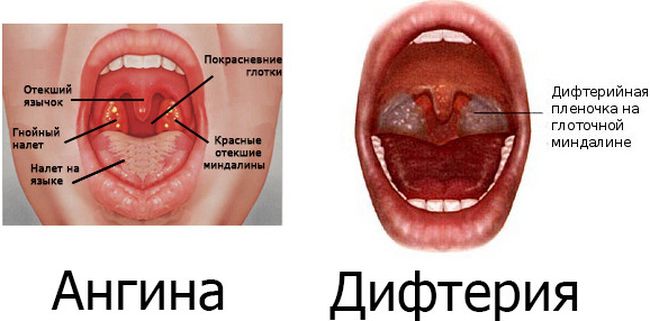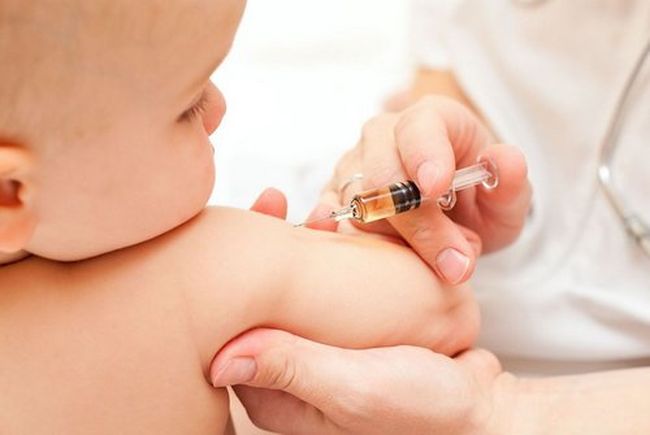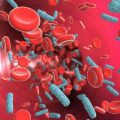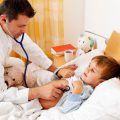diphtheria - risk of infection, causing inflammation of the mucosa of the respiratory tract and severe intoxication of the whole organism. among children, through regular vaccination, disease occurs today only rarely. But in the case of non-vaccination and ignore symptoms, diphtheria in children can cause quite severe consequences, until death.

How does diphtheria in children
It is the causative agent of the disease diphtheria bacillus, which has a sufficiently high resistance, It is allowing the bacteria to persist for a long time everyday objects and everyday life (toys, dish, bedclothes).
Infection can be transmitted by droplets in contact with the patient or diphtheria bacillicarriers. The average incubation period (from the time of infection in the body) It is typically three days, but depending on the severity and localization of the bacteria may be two, and ten days.
The most dangerous for the infection bacillicarriers, since in the absence of external signs of disease, he continues to spread the infection among others.
Contributing factors to infection with diphtheria are general weakness against other of infections and chronic respiratory diseases (eg, chronic tonsillitis). Ie diphtheria often infected children, in which immunocompromised due to an illness or lack of vitamins.
Most often, kids are exposed to the disease at the age of 7 years before 15, grudnichki rarely become infected with diphtheria, tk. they present the so-called passive immunity, derived from mother.
Important! The primary route of infection in diphtheria - airborne, at least - through the surrounding objects.
The organism of diphtheria pathogen most often falls through the mucosa of the nasopharynx or larynx. In rare cases, the pathogen can penetrate the mucous eye, genitals, umbilical wound or damaged skin.
At the point of entry of the pathogen begins to actively proliferate, highlighting exotoxin, which has a local effect on the organism (It causes death and tissue inflammation at the site of) and the overall effect (through the blood spreads throughout the body, affecting all systems and organs). At the site of localization of fibrotic film formed grayish colored pearlescent.
Action exotoxin causing serious complications, because of that and find dangerous disease diphtheria: myocarditis may develop from the heart, impaired heart function (up to a full cardiac arrest), damage to the nervous system can lead to a violation of swallowing function, of view, speeches.
Child very difficult to protect from contact with the carrier infection, and therefore from diseases. The baby did not get sick, do not abandon vaccination and engage in self - it can cost a child's life.

Symptoms and types of diphtheria in children
Diphtheria in children has several clinical forms - depending on the pathogen localization and severity of the disease. In addition, children may meet the combined form of the disease (eg, mouth and nose), that is, when the inflammatory process involves several organs.
The localization of the infection also depends on the age of the child: inflammation in infants can begin in the umbilical wound, in infants is more common nasal diphtheria, children, which was a year, infection affects the throat, and in children over three years - the disease affects mostly the larynx.
diphtheria mouth (oropharynx)
This is the most common form of diphtheria (there is more, than in 90% cases).
The disease and its manifestations depend on the state of the immune system of the child. There are three main forms of the disease:
- Lokalizovannuû;
- poisonous;
- spreading.
Vaccinated children in the event of a localized infection is diphtheria of the throat shape and flows easily or at all expressed in bacteriocarrier.
Not vaccinated children is very difficult to carry diphtheria - clinical signs are growing rapidly, often the disease occurs with complications.
Localized form begins always acutely:
- the temperature rises (to 38-39 degrees);
- An increase in the lymph nodes in the neck;
- Throat starts to hurt.
Tonsillar child appears grayish patina- yellow (or white) colors. First, fibrinous such attacks very thin (like gossamer), but they gradually become denser, and when you try to remove them bleed (cm. a photo).
Common form is registered in rare cases, but it is considerably sharper.
First, the child starts to complain of pain in the throat, while the temperature rises to the limit of 39 degrees and above. In this case, fibrinous raids spread not only to the area of the tonsils, but also far beyond (on the back of the throat, of nёbnыh Dugan). Lymph nodes increase in size, and with pressure on them felt a slight soreness.
The common symptoms of diphtheria throat in children joined signs of intoxication: lethargy, lack of appetite, headache, apathy.
The most severe form - toxic diphtheria is characteristic of non-vaccinated children, when her symptoms of intoxication pronounced:
- Body temperature rises high (may exceed 40 degrees);
- It appears fever, which can result in convulsions;
- Pronounced pallor baby;
- The behavior of the child restless and unstable (from excitement to inhibition);
- Throat swelling appears (earlier, than fibrinous film), which spreads gradually to the cervical spine (up to the clavicle);
- Nasal discharge can go sukrovichnye;
- Mouth sweet heard, Strong smell.
The child's condition is life-threatening - should immediately call the "fast".
note! Symptoms and signs of diphtheria immunization determines the child and his age. The clinical picture of acute and severe in previously unvaccinated children.
diphtheria larynx
It is most common in children between the ages of one and five years and is characterized by a complication in the form of diphtheria (true) groats. Diphtheria of the larynx in children may develop independently or occur against the background of other forms of diphtheria.
Fibrinous plaque gradually grows throughout the laryngeal surface, because of which overlaps the glottis, and it becomes difficult to breathe.
The disease develops as follows::
- The first sign - the temperature is increased to 38 degrees (and higher), the voice becomes hoarse, there is a dry cough, gradually turning into a "barking".
- after 2-3 day develops stenosis stage - breathing becomes difficult and whistling (intermittently), lost voice. Develops respiratory failure (Photo shows, it is difficult to breathe child). Due to respiratory failure child becomes restless, sleeps poorly, skin become bluish tinge.
- If you do not provide timely assistance, comes the stage of asphyxia: pressure drops sharply, pulse rate, temperature is reduced below normal. It can lead to death by suffocation.
diphtheria nose
Usually observed in children, the temperature rises slightly and appear the following symptoms:
- A small swelling of the nose and the associated difficulty in breathing;
- In the nasal mucosa appear fibrinous film;
- Near the nose could be formed cracks and scabs;
- Serous nasal discharge flow (sometimes purulent).
Symptoms of intoxication expressed little.
Other types
In rare cases, infection can affect the eyes, ears, skin, umbilical wounds toddler. At the same time a manifestation of intoxication is almost not expressed, and in the lesion observed raids greyish.
When diphtheria eye eyelid swells, and from the conjunctiva allocated purulent serous fluid.
Infected skin, if they are damaged (scratch, abrasions, cracks). In this case, the skin at the site of injury swells, and formed on the wounds dirty gray powder, which gives them a long time to be tightened.
diphtheria treatment
At the first suspicion of diphtheria child is sent for examination and treatment in hospital (in severe cases - in intensive care).
Treatment of diphtheria in children is appointed after the relevant studies:
- blood test (It determines the presence of diphtheria antitoxin);
- bacteriological sowings (smear from the lesion).

Treat diphtheria in children need an integrated, observing a number of necessary actions:
- Providing rest and bed rest;
- The introduction of antitoxic serum;
- antibiotic therapy;
- Appointment of vitamins and dieting.
The first success of the treatment depends on the timely introduction of the serum against diphtheria bacilli. Antitoxic serum is injected immediately in contact with the child in hospital (ie. without waiting for test results, when the first suspicion of diphtheria). This helps to avoid possible complications, and sometimes even saves the life of a child.
Dosage serum depends on severity of disease and the degree of its flow. If the child has an increased sensitivity to serum components, it is introduced by a special technique in diluted form.
Within 8-12 hours in patients diphtheria comes effect of drug administration, if there is no relief prick serum can do again.
Parallel appointed antibacterial drugs for the purpose of the suspension of the inflammatory process and prevent complications. The following drugs may be administered, depending on the sensitivity of the pathogen:
- gentamicin;
- Tsiprinol;
- tetracycline;
- erythromycin;
- penicillin;
- Dr. ampicillin.
note! Antibiotics are required in combination with diphtheria serum, but instead!
When inflammation of the larynx appointed corticosteroids: prednisolone, Ortadekson, dexamethasone.
When diphtheria croup air baths are recommended (to facilitate the breathing of a sick child), sedatives and desensitizing preparations. In the case of life-threatening applied surgery - tracheotomy.
To remove the common symptoms additionally apply vitamin preparations, antipyretics (panadol for relief, Paracetamol).
To reduce the symptoms of intoxication may be administered intravenously solutions:
- albumin;
- glucose;
- Nekompensana;
- insulin;
- Gemodeza;
- vitamin C.
Of great importance in the treatment of diphtheria in children is the organization proper treatment and care of the baby. From the very beginning of the disease the child needs bed rest and a strong long sleep.
Duration bed regime depends on form of the disease: with mild (localized) form - to 10 days, in severe (toxic) - to 45 days.
Child should follow a diet in the treatment of diphtheria. At the initial stage, when there are acute processes in the throat, the food should be gentle - semiliquid or liquid (soups, cereals, sour). The diet should be balanced, rich in vitamins, helps rid the body of the child from harmful toxins.
When the timeliness of treatment of localized forms of diphtheria have a very favorable prognosis and end in complete recovery of the child. Toxic mold can cause a number of complications in the heart and nervous system, and even be fatal.
How to prevent diphtheria in children
The only reliable prevention of diphtheria in children - timely vaccination.
Vaccination against diphtheria children done by the introduction of the diphtheria toxin, is part of the following vaccines: AKDS (vaccine of stolbnяka, whooping cough and diphtheria) and ADS (vaccine against tetanus and diphtheria).
Planting pediatrician examines child's sensitivity to the drug, and if necessary, appoint more sparing vaccine - Td (diphtheria-tetanus) AD-toxoid or toxoid-M.
To vaccinate children, since the age of three - three times at intervals of 1,5 of the month. Next vaccination is 1,5- 2 of the year, and then grafting is done in 7 and 14 years old.

Minor side effects can be observed in the child on the day of vaccination - a slight fever, Local reaction to the drug (redness or induration at the site of inoculation). In general, vaccination is without complications and adverse reactions.
Diphtheria - one of the most dangerous infections for baby, which can lead to serious pathologies and, not infrequently, to death. The success of treatment depends entirely on the timely treatment for medical assistance. therefore, as soon as the child starts to become ill and there are characteristic symptoms of diphtheria, should immediately see a specialist.












